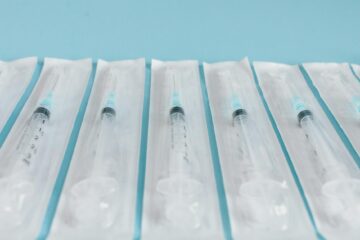You’ve made it through whelping, and now you have a basketful of beautiful puppies. Are they healthy? How do you know? Below, I’ll outline 6 recommendations to maximize your puppies’ health in the first 8 weeks.
Check for cleft palates
A cleft palate is a defect in the roof of the puppy’s mouth. It is incredibly important to check for cleft palates immediately after the puppy is born – BEFORE they start nursing. Some puppies with minor defects may still be able to nurse, but if they have a large defect they are at risk of inhaling milk into their lungs, which can lead to pneumonia, which is almost always a death sentence in newborn puppies. Puppies with large defects should be tube-fed until they are old enough to have surgery to repair the defect and/or eat solid food.
I’m not going to sugarcoat this – tube feeding is a LOT of work. Newborn puppies must be fed every 2 hours around the clock – yes, even through the night – and tube feeding is not without its risks. Subjectively, tube-fed puppies often become very sociable and snuggly (and mayyyybe extra spoiled) because of the additional handling they receive, so many breeders find it rewarding to work with them.
There are some great photos of cleft palates included in this article!
Weigh them, weigh them, weigh them
Puppies should be consistently gaining weight. I recommend using a digital food scale for this purpose. Puppies should be weighed when they are born and then at least once per day (I prefer twice per day) at the same time every day. It’s often difficult to get puppies to stay on the scale, so it is often helpful to have a container with sides to keep them in place!
In the first 24 hours, it is common for puppies to lose up to 10% of their birth weight. After that point, they should gain 5-10% of their body weight each day. If they lose weight or they are not gaining, something is wrong and they should be evaluated by a veterinarian.
Deworming
Puppies have worms. Yes, your puppies too. There are microscopic worm eggs in your yard, in your house, and on the dam’s fur. Puppies lick everything and thus acquire worm eggs, which anchor in their intestines and become worms. The worms grow fat and happy on all the nutrition that should be going to the puppy. Worms aren’t just gross, they can make puppies sick and die. Additionally, many types of worms are zoonotic, which means that YOU can get them too. Depending on the type of worm, they can crawl through your skin (or your childrens’ skin) or even cause blindness if they get into your eye. Yikes.
The solution? Dewormers. (Also, wash your hands) Puppies should be dewormed at 2 weeks, 4 weeks, 6 weeks, and 8 weeks. Pyrantel pamoate is a common dewormer that is available at most pet stores and feed stores. The dose is 10 milligrams per kilogram of body weight, but when determining volume to give the puppies, BE CAREFUL because there are two different products out there – one is 4.54 mg/mL and the other is 50 mg/mL – a big difference! Mom should also be dewormed with the puppies at 2 weeks, then as needed based on fecal analysis results.
Have a thermometer handy
Newborn puppies cannot regulate their body temperature. Instead, they rely entirely on the ambient temperature in the room as well as the body heat of their mother and siblings. Cold puppies = dead puppies. Get a rectal thermometer and use it only in your pets. Make sure you label it and don’t store it with your human thermometer so there’s no chance of confusing the two (yuck).
Normal body temperature for a newborn puppy is 96-99 degrees F and it increases approximately 1 degree per week. The ambient temperature in the room/around newborn puppies should be 75-80 degrees F.
If a puppy is cold, they need to be gradually warmed. There are multiple ways to do this – heat lamps, heating pads, heating water bottles, heating rice packs, etc. Some people have very strong opinions about the correct or incorrect implement to use. I feel that it’s important for us to acknowledge that any heating device can burn a puppy. Therefore, we must use caution no matter what we choose. A puppy should never be placed directly touching heating pads/bottles/discs/packs and instead a towel should be placed between the puppy and the heating object to protect the puppy from burns. Heating pads should be on the lowest setting and heat lamps should be securely attached so they can’t fall.
If the puppy’s body temperature is normal and the puppy is not acting right or has lost weight (see #2), they should be evaluated by a veterinarian.
Practice good hygiene and biosecurity
Raising puppies is a messy business. First, there are post-birth discharge and fluids everywhere, then poop and pee, then mushy puppy food, then dirt, mud, and other miscellaneous debris. This mess will be on the puppies, on mom, on the floors, and on you. Maintain good hygiene by changing the bedding when it gets soiled and cleaning the puppies if mom isn’t doing it for you.
When it comes to biosecurity, be at least a little paranoid. No new dogs should be coming into your home/kennel and your current dogs should avoid places with potentially unvaccinated dogs. Keep in mind that this may include your own backyard if you share a fence line with other dog-owning neighbors.
Although it can be safe for mom and puppies to be exposed to other healthy, vaccinated dogs who are comfortable around puppies (such as other dogs in the household), overall mom and puppies should be quarantined from exposure to others. Quarantine means that they never come into contact with each other, including through sources like YOU. Wash your hands before you touch or handle the puppies. When people come over to see the adorable puppies, require them to wash their hands as well. Consider also providing shoecovers for them – you have no idea what they’re carrying on their shoes. Frankly, they probably don’t know either. Is it awkward? Maybe. But if they try to refuse then they don’t have the best health of the puppies in mind anyway, so do you really want them as a risk?
Early neurologic stimulation
Early neurological stimulation is a process reportedly (more on that later) developed by the US military and designed to improve an individual dog’s ability to handle stress. There is a series of five exercises to be performed on each puppy once per day.
– Hold the puppy with its head pointing up for 5 seconds
– Hold the puppy with its head pointing down for 5 seconds
– Hold the puppy on its back for 5 seconds
– Touch any one foot with a Q-tip for 3-5 seconds
– Place the puppy on a cool, damp towel for 5 seconds (do not hold them in place)
For pictures, visit this link.
I’m going to be super honest with you here – I tried really hard to find the original research for this process so I could confidently share that I had analyzed the data and found it to be valid… but I couldn’t find it. All I can find out there is the non-peer-reviewed article written by the person who first popularized it (link above) and then other sites parroting that source. If anyone out there has more concrete data, please contact me!
All that being said, there is also no data to indicate that this process is detrimental and it‘s relatively easy to do. So maybe it matters or maybe it doesn’t, but it’s not likely to hurt and it might help, so why not?
Early socialization
Puppies (and kittens, and babies, etc) have a limited period early on that ”sets the stage” for their entire life. This sensitive period in puppies lasts from approximately 3 weeks of age to 12 weeks of age.
This is not to say that puppies stop learning after 12 weeks, of course. Even a puppy who has adequate early socialization can develop detrimental behaviors based on their later experiences and a puppy without early socialization can adjust to experiences they didn’t have early on, but it does become more difficult. A puppy who learns to only pee on leaves may struggle when you go on a road trip and there aren’t any leaves at the rest stop. A puppy who doesn’t meet children, people in hats, people with canes, people on bicycles, etc may fear those individuals as an adult. My late cattle dog mix was terrified of little girls on bicycles, balloons, and, once, a large pile of pillows.
I’d venture to say that it’s impossible to expose your puppy to everything they’ll ever experience in their life within their first 12 weeks, but that isn’t the point. The goal is to expose them to as much as possible in a safe and structured way so they can have the best chance at a healthy life with minimal anxiety. As a breeder, you have an integral role to play in this timeline. As most puppies go to their new homes around 8 weeks, over half of the socialization period is in your control!
There are various systems and techniques to help you organize these efforts, including Fear Free Pets, Dr. Sophia Yin’s Perfect Puppy book, and Puppy Culture. They all include exposure to similar experiences – children, men, surfaces, machines, sounds, animals, etc. Follow along on my Instagram for updates on my own puppy’s socialization bingo!
What other techniques do you use to help your puppies stay healthy? Share in the comments below!



4 Comments
Cheryl · January 31, 2020 at 10:39 am
Could you please give both dosage amounts for pyrantel pamoate? You mentioned two strengths (4.54mg/ml and 50mg/ml) you can obtain, however you only have one dosage (10mg/ml per kg per listed. Is that for the 4.54mg/ml? And, basically 1-mg/ml per kg for the 50mg/ml? ( or just move the decimal point over?)
Dr. Kristina Baltutis · February 1, 2020 at 8:07 am
Hi Cheryl!
The dosage is 10 milligrams of pyrantel per kilogram of body weight (10 mg/kg) regardless of the concentration.
If you have the 4.54 mg/mL concentration, the volume will be 2.2 mL/kg (10 mg/kg divided by 4.54 mg/mL), which coincidentally is 1 mL/lb.
If you have the 50 mg/mL concentration, the volume will be 0.2 mL/kg (10 mg/kg divided by 50 mg/mL), which is (approximately) 0.1 mL/lb, which is also equivalent mathematically to “moving the decimal point over.”
I tend to be a little bit of a math purist when it comes to conversions. I blame it on teaching high school chemistry before going to vet school 🙂 Thank you for reminding me that I need to be a little more explicit!
In summary:
If the concentration is 4.54 mg/mL, give 1 mL per pound of body weight.
If the concentration is 50 mg/mL, move the decimal to the left one place (i.e. 30 pounds becomes 3 mL, 10 pounds becomes 1 mL, 5 pounds becomes 0.5 mL, etc)
AffiliateLabz · February 15, 2020 at 4:30 pm
Great content! Super high-quality! Keep it up! 🙂
Thinking About Breeding Your Dog So The Kids Can Experience the “Miracle of Birth?” Do This Instead. – Well Bred Veterinary Services, PLLC · March 18, 2020 at 6:30 am
[…] Volunteer as a foster family for a local animal shelter or rescue. These organizations are always looking for more responsible foster families, and pregnant momma-dogs are often especially challenging to place because they come with a LOT of responsibility! Shelters aren’t the best place for pregnant moms and puppies because they have weaker immune systems and shelters have a lot of potential for exposure to sick dogs. Give these babies a great start! […]